Single Property
Individual addresses, buildings, or lots/areas are defined as being the entire physical property including all adjoining public rights of way. Excavators may be more specific and limit what needs to be located on a property, but they may not expand upon this definition.
EXAMPLE 1: Corner property
Scenario: The work will take place in the front of property and along both roads that border the property.
Locate Instructions: Locate the front of the property and the right of way for the corner lot, to include the property side of Summit Ridge Pkwy. and Peachtree Industrial Blvd.
(This can be requested on a single ticket.)

Multiple Properties
If work will take place on multiple individual pieces of properties, a maximum of five (5) individual addresses, buildings, or lots/areas will be allowed per ticket, not to exceed more than one (1) linear mile between the first and last address on a single street.

A maximum of ten (10) addresses, buildings or lots/areas can be requested in the same geographical area before a Large Project ticket is required.
Large Property
If work will take place on a large property or facility such as strip mall, shopping center, airport, etc., (99 acres or less) a maximum of five (5) buildings or lots/areas will be allowed per ticket. A maximum of two tickets (ten buildings or common areas) can be requested before a Large Project ticket is required.
If the excavator is excavating on a large property (100 acres or more) or area that will take more than 90 days of excavation to complete, then a Large Project ticket must be requested. There is no maximum acreage that can be requested under a Large Project.
Regarding apartment complexes, townhomes, condominiums or mobile home communities, etc., a maximum of five (5) buildings or other common areas such as pool-area, clubhouse, tennis-court, entrance, etc., may be included on one ticket, not to exceed one (1) mile on a single street. A maximum of two tickets (ten buildings or common areas) can be requested before a Large Project ticket is required.
EXAMPLE 2: Apartment Complex
Scenario: Excavation will occur at buildings A-1000, B-2000 and Tennis Court inside Summit Ridge Apartments.
Locate Instructions: Locate 50 feet offset around buildings A-1000, B-2000, and Tennis Court.
(This can be requested on a single ticket.)
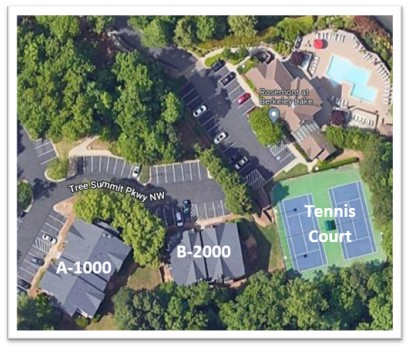
EXAMPLE 3: Townhome Community
Scenario: Excavation will occur at buildings 4 and 5 on Thayer Trace, in the Buckhead Townhome Community.
Locate Instructions: Locate a 50-foot offset around buildings 4 and 5 on Thayer Trace.
(This can be requested on a single ticket.)

Single Street
Any ticket requesting a single street for one linear mile or less may include:
EXAMPLE 4: Single Street exceeding one (1) linear mile
Scenario: Excavation will occur for a total distance of 1.85 miles on a single road.
Locate Instructions: Locate the right of way on both sides of Brockett Road from Lawrenceville Highway going south to Cooledge Road.
(This scenario requires a Large Project ticket.)
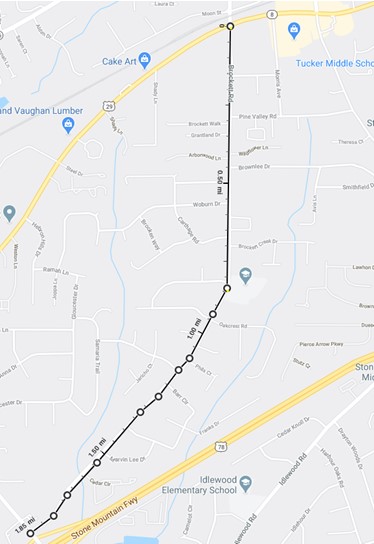
Intersection
The locate instructions for an intersection begins at the center point of the requested intersection, may not exceed 300 feet in all directions, and may include the right of way on both sides of the roads.
If an excavator needs additional footage exceeding 300 feet in any direction at an intersection, then additional tickets must be issued in compliance with this Ticket Size Policy.
EXAMPLE 5: Single intersection 300 feet in each direction
Scenario: Excavation requires 300 feet in all directions of the right of way of the intersection of Oak Lane and Elm Street.
Locate Instructions: Locate 300 feet in all directions of the intersection of Oak Ln. and Elm St., including the right of way on both sides of the road.
(This can be requested on a single ticket.)

EXAMPLE 6: Single intersection 400 feet in each direction
Scenario: Excavation requires 400 feet in all directions in the right of way of the intersection of Oak Lane and Elm Street.
(This scenario requires 2 separate tickets.)

Locate Instructions for Ticket 1: Starting at the intersection of Elm St., locate the right of way on both sides of Oak Ln. going 400 feet southwest and 400 feet northeast.

Locate Instructions for Ticket 2: Starting at the intersection of Oak Ln., locate the right of way on both sides of Elm St. going 400 feet southeast.
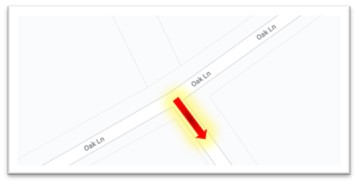
Multiple Streets
EXAMPLE 7: Single street for 1,200 feet and 400 feet along intersecting street
Scenario: Excavation at an intersection requires 600 feet in both directions along Oak Lane and 400 feet along Elm Street.
(This scenario requires 2 separate tickets.)
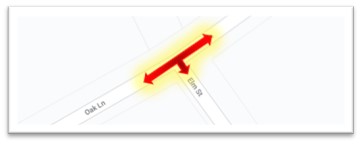
Locate Instructions for Ticket 1: Starting at the intersection of Elm St., locate the right of way on both sides of Oak Ln. going 600 feet southwest and 600 feet northeast.
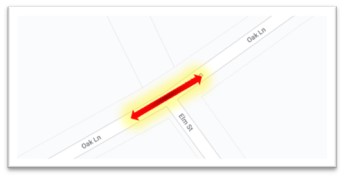
Locate Instructions for Ticket 2: Starting at the intersection of Oak Ln., locate the right of way on both sides of Elm St. going 400 feet southeast.
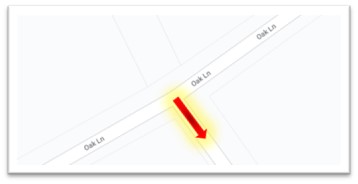
EXAMPLE 8: Street with multiple intersections
Scenario: Excavation will occur on both sides of Summit Ridge Parkway between Peachtree Industrial Boulevard and Pleasant Hill Road, including all intersections for 100 feet in all directions.
Locate Instructions: Locate the right of way on both sides of Summit Ridge Parkway from Peachtree Industrial Blvd. to Pleasant Hill Rd., including 100 feet in all directions at all intersections.
(This can be requested on a single ticket.)

Unnamed Street
For excavation on an unnamed street, the excavator needs to assign names or labels to the street in question. This can be as simple as Street A, Street B, Street C, etc. A ticket may then be entered for each street. There must be a note placed in the remarks field of the ticket that the excavator assigned the street names or labels and the excavator may provide a map of the area directly to the facility owner operator if necessary. The excavator may also need to provide specific driving directions in the remarks field (i.e., for new developments or subdivisions). If the excavator is excavating on multiple unnamed streets in the same geographical area that when added together exceeds one (1) linear mile, then a Large Project ticket must be requested.
EXAMPLE 9: Unnamed street in a new development
Scenario: The dig site street is on an unnamed street, “Street A”. The nearest intersecting street is Brandon Place.
Locate Instructions: Locate the right of way on both sides of Street A for the entire length of the road (300 feet).
Remarks: From the intersection of Thompson Bridge Road and Brandon Place, travel west on Brandon Place and “Street A” is the first street on the left.
(This can be requested on a single ticket.)
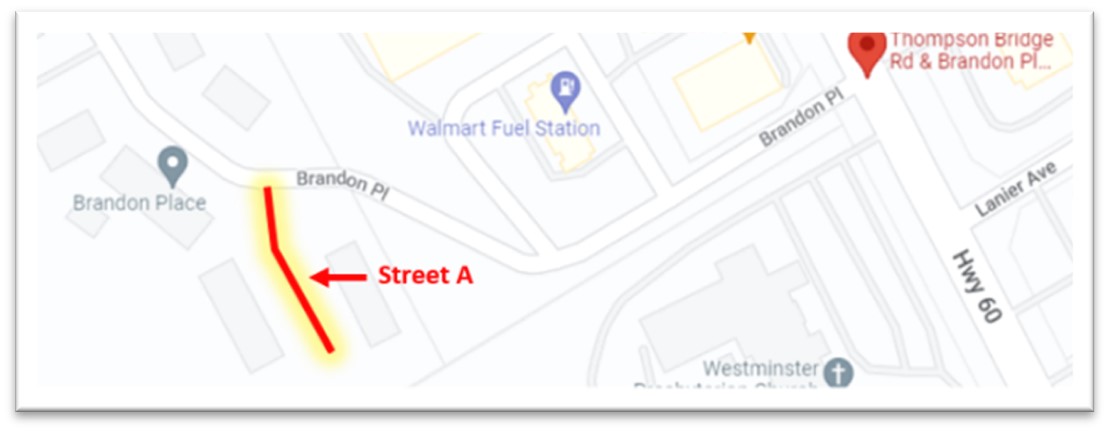
EXAMPLE 10: Unnamed street in a new subdivision
Scenario: The dig site street is on an unnamed street, “Street B”.
Locate Instructions: Locate the right of way on both sides of Street B for the entire street.
Remarks: This is a subdivision with unnamed streets. “Street A” is on the west side of Miravista Way directly across from Alder Ct. “Street B” is located at the end of “Street A”.
(This can be requested on a single ticket.)
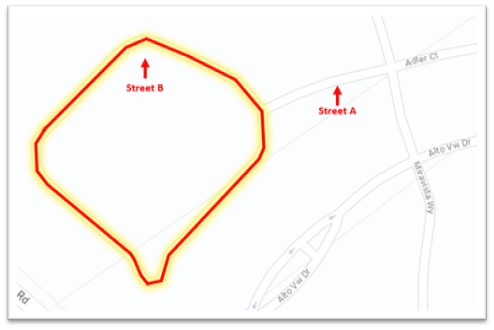
Cross-country locates are tickets requesting areas across fields or countryside, as opposed to on roads. Any ticket requesting a cross-country locate such as, but not limited to, gas transmission pipeline, power transmission line, or railroad tracks, may not exceed one (1) linear mile from the starting point to the ending point. Driving directions must be provided in the remarks field of the ticket.
EXAMPLE 11: Power transmission line
Scenario: Excavation will occur along the power transmission line.
Locate Instructions: Locate a 50-foot radius around the following 2 structures: #25 and #26. Structure #26 is 1,800 feet going in a northeast direction along the transmission line from structure #25.
Remarks: Access this transmission line from the rear of address 78 Orchard Drive. Exit the transmission line at the substation on Ridgeway Drive.
(This can be requested on a single ticket.)

An excavator may request up to one (1) mile along an interstate when work will take place in the road or along the shoulder of the traveled road. The direction of traffic or travel must be specified on the ticket, i.e., northbound, southbound, eastbound, westbound, etc. Each directional lane is to be treated as an individual road.
Please note the following for Interstate tickets:
EXAMPLE 12: Interstate 75 northbound
Scenario: Excavation will occur along the shoulder of I-75 northbound for 1 mile.
Locate Instructions: Locate a 25-foot offset along the east side of I-75 northbound from mile post 17 to mile post 18.
(This can be requested on a single ticket.)
